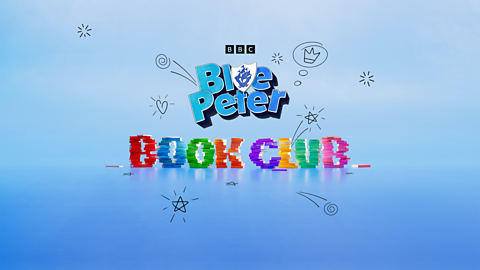What is the book about?
This guide is produced in partnership with Blue Peter.
The Breakfast Club Adventures: The Beast Beyond the Fence, written by Marcus Rashford with Alex Falase-Koya and illustrated by Marta Kissi, is the ninth title in the Blue Peter Book Club.
When Marcus kicks his favourite football over the fence, he knows he's never getting it back. But when he's invited to join the Breakfast Club Investigators, he's soon part of an exciting adventure with Stacey, Lise and Asim to find out what's on the other side of the fence – and get his football back!
You can get a sneak peek of the book over on Blue Peter.
Football fanatic, Marcus has lost his ball over the school fence and knows that it's probably gone forever.
But when he receives a mysterious invitation to join the secret society of breakfast club investigators, Marcus and his new mates embark on an adventure to retrieve his ball and work out what mysterious forces lie on the other side of the fence.
What is a story's message and what does it tell the reader?
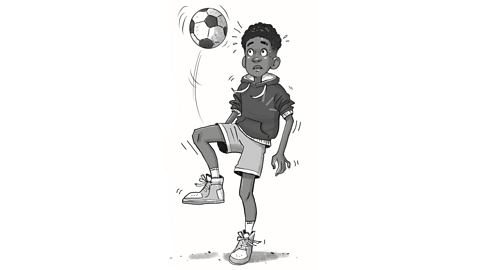
Did you enjoy reading The Breakfast Club Adventures? With its fast pace and mystery you will have been entertained and on the edge of your seat throughout.
But… did you notice the messageThe main idea that a story centres around. that the story was also trying to share with you?
Authors, like Marcus Rashford and Alex Falase-Koya, often try to weave a message into a story. A message is the big idea that the story centres around.

At first, it's easy to think that The Breakfast Club Adventures is all about Marcus getting his ball and his 'touch' back.
In reality, the whole story is based upon one simple message: the importance of family, friends and teamwork. We know this because Marcus constantly relies on the excellent relationships he has with others in order to overcome the challenges he faces.
In the end, the key message of The Breakfast Club Adventures is made extremely clear when Marcus relies on his friends, his family and teamwork to solve the mysterious case of the chupacabra.

How are some words made to standout and why?
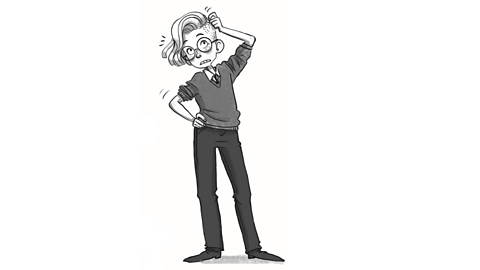
The text in The Breakfast Club Adventures is sometimes presented in a very interesting way.
You will notice that some of the words in the book are larger than others or written in a different font styleThe way the writing looks. (what the actual letters look like). But why?
Using a different font size and style has been used in order to emphasiseMaking something standout so that people pay attention to it. important words.
When a word is emphasised it stands out, so that you really pay attention to it! This makes the writing more interesting and exciting to read.
In The Breakfast Club Adventures, the font styles used try to emphasise the action that is happening and help create an image in your mind, for example:

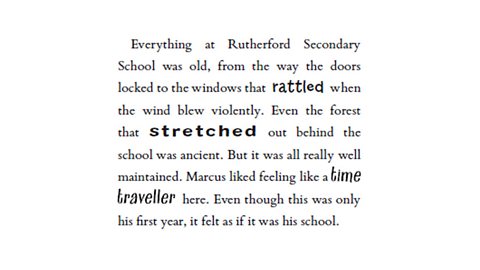
Image caption, The word 'stretched' is written in a stretched out way.
Image caption, The words 'Over the fence' are written in a creepy font style to give you a feeling of being scared.
Image caption, 'Thumping' has been written with short lines above it as if the word is actually thumping like Marcus' heart.
1 of 3
What is 'show not tell' and how is it used?
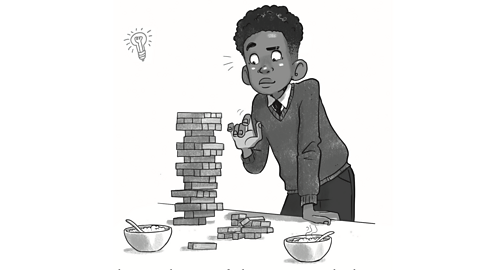
Description is important in any story, especially stories like The Breakfast Club Adventures.
But sometimes, a long detailed description can be a bit boring for you to read. That's why writers often use a technique called show not tellA descriptive writing technique where the writer encourages the reader to create an image in their heads by not directly describing something..
Show not tell encourages you to think and engage with the story as you read. This might be when you are trying to visualise a character, a setting or some action that is taking place.

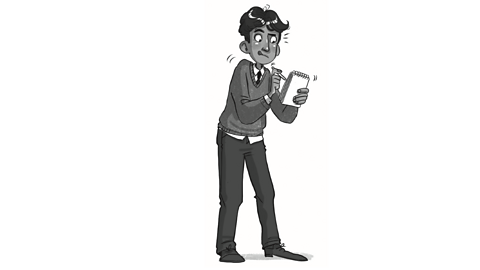
The important thing to remember when using show not tell is that the writer does not directly tell the reader what they are describing.
Take a look at these examples from the story.
"He looked up at Amira with an eyebrow raised." (page 2)
Rather than just saying that 'Marcus wasn't too sure about what Amira was saying,' it is more interesting to describe him raising an eyebrow as a signal of his uncertainty.

"Lise wrapped her arms around her body." (page 153)
The authors could have just said that Lise didn't like what she saw; however, a clearer image of how she feels is created by describing what she does with her arms instead.
"The hair on Marcus' arms stood on edge."(page 80)
It would be quite boring to just write "Marcus was nervous." Instead, describing what happened to the hair on Marcus' arms creates a much more interesting image of how he feels.
What are short, snappy sentences and why are they used?

The Breakfast Club Adventures contains lots of fantastic writing techniqueThe skills, tricks and tips that writers use to make their writing interesting or informative for the reader.. Apart from show not tell - did you spot any others?
short, snappy sentencesShort, quick sentences that build tension, urgency and mystery. They sometimes come together in twos or threes. are another writing technique used well throughout the story.
But what are short, snappy sentences?

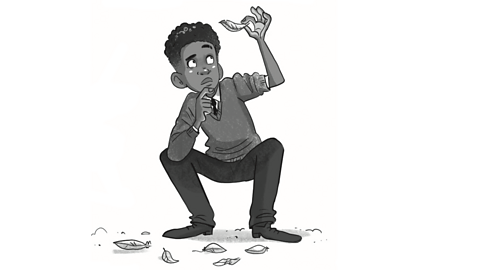
Take a look at the examples below.
"Then he remembered. Today, they were going over the fence. He and the Breakfast Club Investigators." (page 55)
"The thing took a step forward. Marcus's jaw hung open. He couldn't close it." (page 81)
"They were not alone." (page 229)

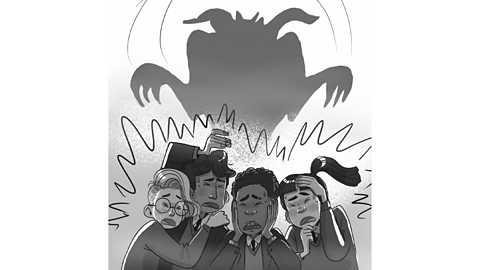
As you can see, short snappy sentences are small, quick sentences that are often easy to read. Sometimes, you might get two or three of them in a row!
But why do authors use them?
Using short, snappy sentences is a writing technique that has a powerful impact. They give the reader a sense or feeling that:
- something mysterious is happening
- tensionA feeling of nerves, worry or fear. is building (a feeling of nerves, worry or fear)
- something needs or is going to happen quickly (urgency)
As you know from reading The Breakfast Club Adventures, there are lots of mysterious events and moments with lots of tension. Therefore, short snappy sentences have been purposefully used by the authors to build tension and a sense of mystery throughout the story.

Activity 1
Now that you understand the writing technique 'show not tell' it's your turn to give it a try!
Imagine that you are describing the moment Marcus is dragged through the woods by the chupacabra. He would be feeling terrified, anxious and maybe a bit sore!

Your challenge is to think about what different parts of his body might be doing to show these feelings. Try to describe these features:
- Marcus' face
- Marcus' body
- Marcus' voice
Struggling to think of an idea? Here's some help!
Marcus' voice sounded like a plate of jelly. His bottom lip trembled and his body was frozen still.
Activity 2
Short, snappy sentences are a great writing technique for building tension and urgency.
In this quiz, can you identify which sentence (or sentences) are short and snappy?
Activity 3
Throughout the story action words or sound words were emphasised (made to stand out) by using a different font or font style.
Your task is to read each of these sentences and write out the word that you think should be written in a different font size and style so that it's emphasised and stands out.
Why not have a go at re-writing the sentence and writing the emphasised word out as it might be in the book.
- We just have to reach out and grab them.
- The howl sent shivers up Marcus' spine.
- Loud crashes were coming from inside the hut.
- It was giving off an unpleasant smell.
- The monster started to walk towards them menacingly.
Answers.
- We just have to reach out and grab them.
- The howl sent shivers up Marcus' spine.
- Loud crashes were coming from inside the hut.
- It was giving off an unpleasant smell.
- The monster started to walk towards them menacingly.
More on Blue Peter Book Club
Find out more by working through a topic
- count11 of 13
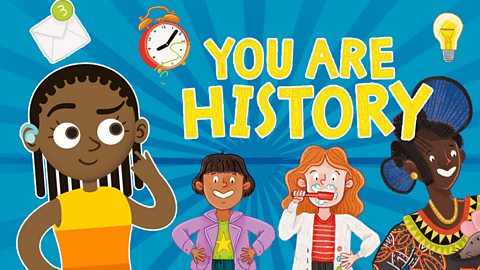
- count12 of 13
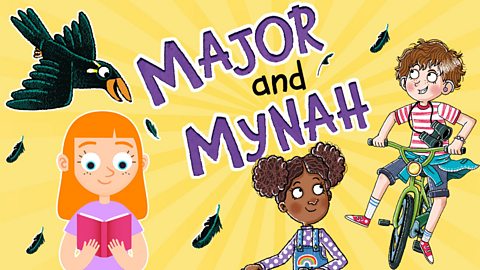
- count13 of 13

- count1 of 13
